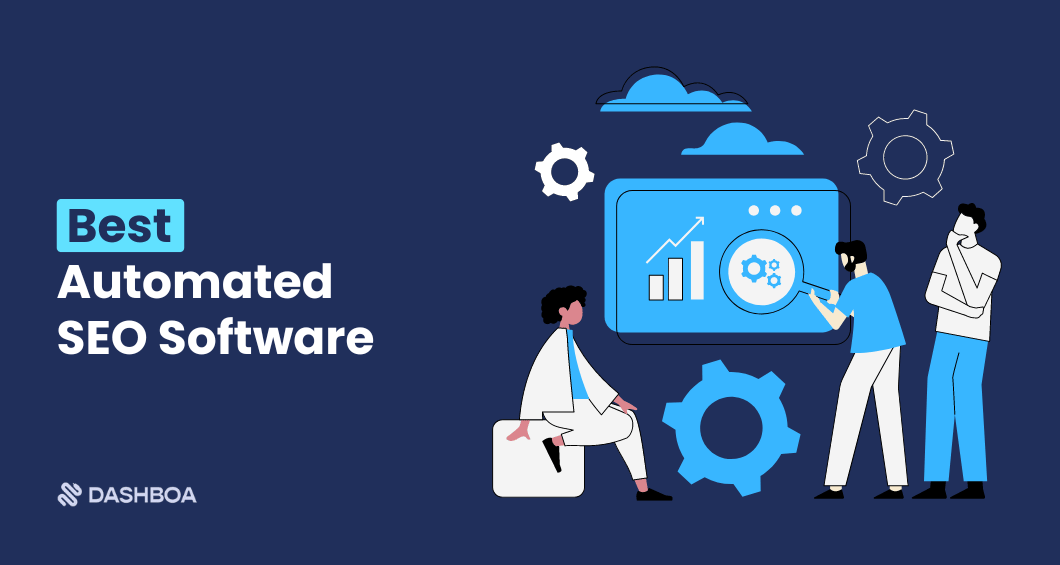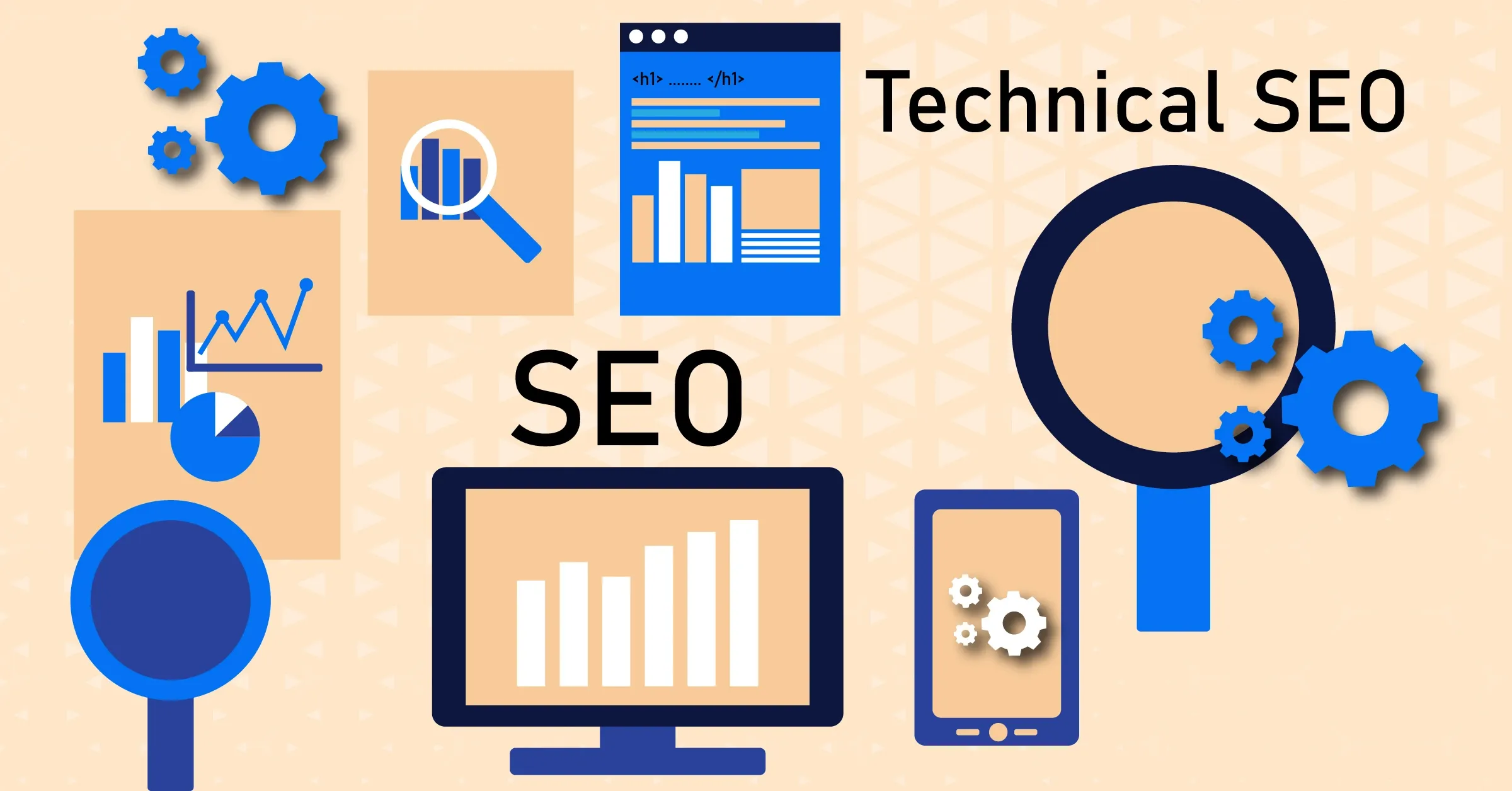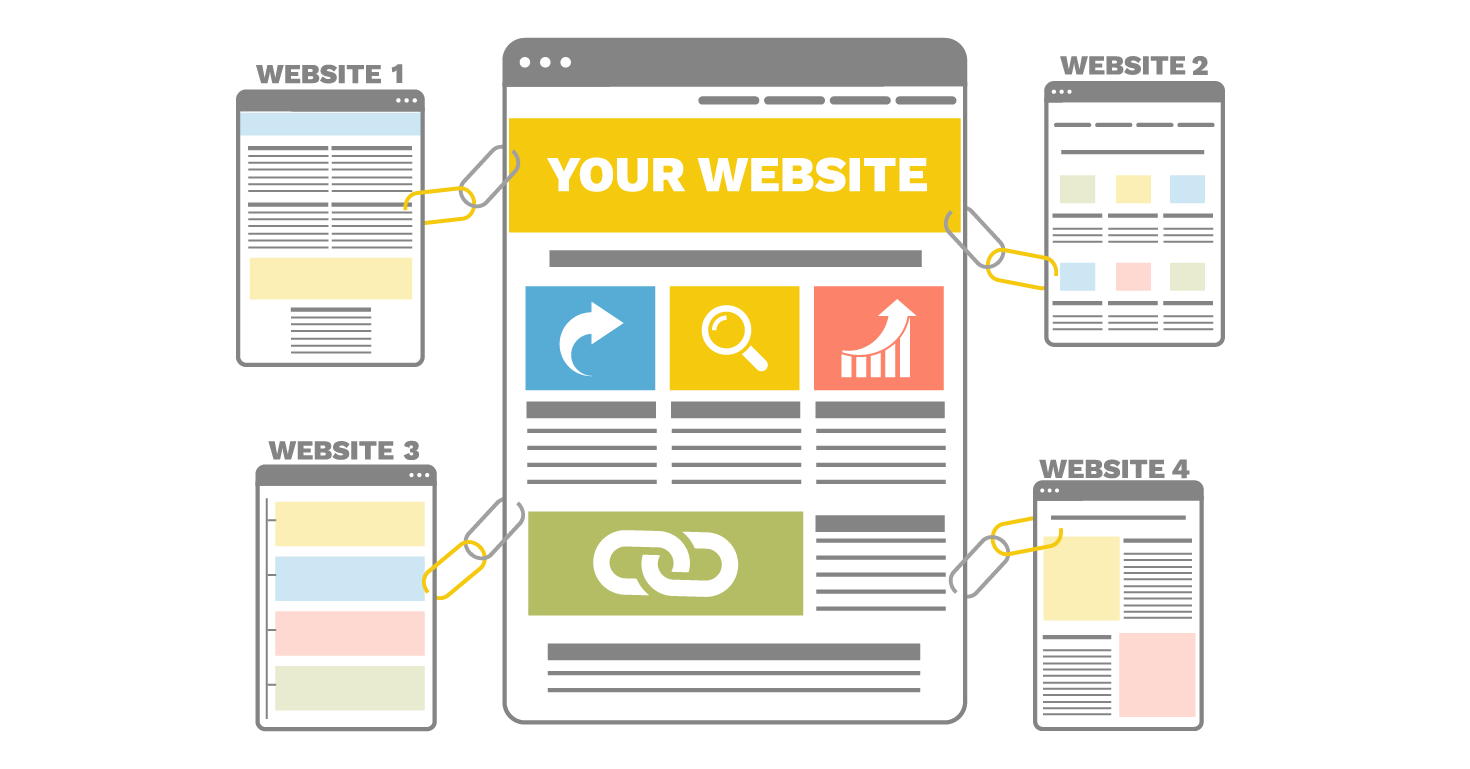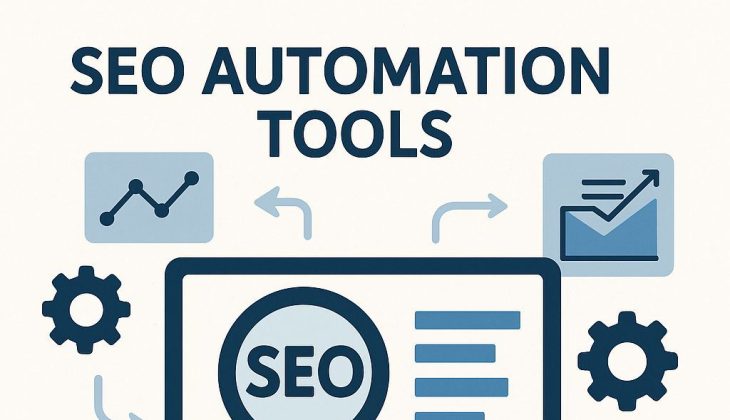Key Takeaways
- SEO automation tools can save up to 15–20 hours weekly by automating keyword tracking, audits, and content optimization.
- Combining automated SEO software like Semrush and Surfer SEO with manual strategy delivers optimal performance.
- AI SEO tools help teams create optimized, scalable content without sacrificing quality.
- The best SEO task automation approach blends data-driven automation with human creativity for consistent, high-impact results.
- Even free SEO automation software can deliver strong ROI when used strategically.

“11 Best Automated SEO Software to …” from dashboa.com and used with no modifications.
The SEO landscape has dramatically shifted toward automation, with tools that can now handle everything from keyword research to content optimization with minimal human intervention. If you’re still manually tracking rankings, auditing websites, or creating content briefs, you’re wasting valuable time that could be better spent on strategy. The right SEO automation tools can transform your productivity while maintaining or even improving results.
At Market Business Watch, we researched dozens of SEO automation solutions to identify which ones deliver genuine time savings without sacrificing quality. Our analysis reveals that implementing the right automation stack can reduce your SEO workload by up to 65% while improving consistency and scalability.
SEO automation isn’t just a luxury—it’s becoming essential for staying competitive in an increasingly complex digital landscape. With Google’s algorithms growing more sophisticated and competitors leveraging AI-powered tools, manual processes simply can’t keep up with the pace of change or the volume of work required for effective SEO campaigns.
13 Best SEO Automation Tools That Actually Save Time
After evaluating over 50 tools, we’ve identified 13 solutions that deliver meaningful automation capabilities for different aspects of SEO. These tools have been selected based on their ability to reduce workload, improve consistency, and deliver measurable results across various SEO disciplines.
Why Manual SEO Work Is Killing Your Productivity
The average SEO professional spends 60+ hours monthly on tasks that could be partially or fully automated. Tasks like rank tracking, backlink analysis, and competitive monitoring consume vast amounts of time while providing limited strategic value when done manually. By automating these processes, you free up mental bandwidth for activities that actually move the needle: strategy development, relationship building, and creative problem-solving.
Consider how much time you currently spend checking rankings, monitoring technical issues, or gathering data for reports. Now imagine reclaiming that time while getting more consistent results. That’s the promise of SEO automation done right—not replacing human expertise but enhancing it by handling the repetitive, data-heavy aspects of SEO.
What Tasks You Should (and Shouldn’t) Automate
Not all SEO activities benefit equally from automation. Understanding where automation provides the greatest return on investment is crucial for building an effective tech stack. Repetitive, data-intensive tasks with clear parameters offer the best automation opportunities, while creative and strategic activities generally require human judgment.
Tasks ideal for automation include rank tracking, technical SEO audits, backlink monitoring, competitor analysis, and reporting. These processes follow predictable patterns and benefit from consistent execution at scale. On the other hand, strategic decisions, content ideation, and relationship building typically require human intuition and should remain primarily manual with technological assistance.
The sweet spot for many businesses lies in semi-automation—using tools to gather data, identify opportunities, and streamline workflows while keeping humans in the decision-making loop. This hybrid approach leverages the strengths of both automation (speed, consistency, scale) and human expertise (creativity, judgment, nuance).
- Best for automation: Technical audits, rank tracking, competitive monitoring, reporting, data collection
- Semi-automation candidates: Content optimization, keyword research, link prospecting, on-page SEO
- Minimal automation: Strategy development, content ideation, relationship building, creative problem-solving
On-Page SEO Automation Tools Worth Your Money

“Advanced On-Page SEO Tips: Best …” from www.convertmate.io and used with no modifications.
On-page optimization represents one of the most time-consuming aspects of SEO, but also one of the most impactful areas for automation. The right tools can transform hours of manual analysis into seconds of automated insight, helping you optimize content faster and more effectively than ever before.
1. Surfer SEO: AI-Powered Content Optimization
Surfer SEO has revolutionized the content optimization process by automating competitive analysis and providing real-time content scoring. The platform analyzes top-ranking pages for your target keywords and generates a comprehensive content brief with specific recommendations for word count, keywords, headings, and more. This automation eliminates hours of manual competitive analysis while providing data-driven guidelines for content creation.
What makes Surfer particularly powerful is its integration capabilities with Google Docs and WordPress, allowing writers to optimize content in real-time as they create it. The platform’s Content Editor provides instant feedback on content quality and relevance, automatically checking for keyword usage, content structure, and topical coverage. For teams producing high volumes of content, this automation can save 3-4 hours per article while improving overall content quality and search performance. If you’re interested in exploring more tools that can enhance your SEO strategy, check out these best web scraping tools for SEO.
2. Clearscope: Data-Driven Content Planning
Clearscope takes a slightly different approach to content optimization automation, focusing on comprehensive term analysis and content grading. The platform automatically analyzes the top 30 search results for your target keyword, identifying the most relevant terms and concepts that should be included in your content. This automated competitive analysis provides a clear roadmap for content development based on what’s actually working in search results.
What sets Clearscope apart is its sophisticated content grading system, which automatically evaluates your content against top-performing competitors and assigns a letter grade based on relevance and completeness. The platform also provides automated readability analysis, helping ensure your content meets both search engine and user requirements. For content teams focused on quality and relevance, Clearscope’s automation capabilities can dramatically reduce the research phase while improving content performance.
3. Frase: Streamlined Content Brief Creation
Frase has established itself as a powerhouse for automating the content brief creation process. The platform automatically analyzes top search results and extracts the most important topics, questions, and keywords in seconds, transforming hours of manual research into an instant content brief. This automation is particularly valuable for content teams producing high volumes of SEO-focused content across multiple topics.
Beyond brief creation, Frase offers powerful AI writing assistance that can automate portions of the content creation process itself. The platform can automatically generate outlines, introductions, and even full sections based on your brief, significantly accelerating content production. For agencies and in-house teams handling large content calendars, Frase’s combination of research automation and AI writing assistance can reduce content production time by up to 50% while maintaining quality standards.
Technical SEO Automation That Solves Real Problems

“The Complete List of Technical SEO Tools” from www.gigde.com and used with no modifications.
Technical SEO issues can derail even the best content strategy if left unchecked. Automation tools in this category scan thousands of URLs, identify critical issues, and monitor changes in real-time—tasks that would be impossible to perform manually with any consistency.
The right technical SEO automation tools don’t just identify problems—they prioritize them based on impact and provide clear action steps for resolution. This transforms technical SEO from a reactive firefighting exercise to a proactive, systematic process.
1. Screaming Frog: Bulk Site Auditing
Screaming Frog remains the gold standard for automated technical SEO auditing, capable of crawling up to 500 URLs for free or unlimited URLs with a license. The tool automatically identifies over 100 technical issues including broken links, redirect chains, duplicate content, missing meta data, and crawl errors. What makes Screaming Frog particularly powerful is its ability to export custom reports and integrate with Google Analytics and Search Console, providing a comprehensive view of technical performance across massive websites.
2. Sitebulb: Automated Technical Issue Detection
Sitebulb takes technical automation a step further by not just identifying issues but explaining why they matter and how to fix them. The platform’s Hints system automatically analyzes crawl data and translates technical findings into plain English explanations with clear priority levels. This automation layer makes technical SEO accessible even to non-specialists and streamlines the troubleshooting process. Sitebulb’s visualization capabilities also automatically generate site architecture maps, highlighting structural issues that might otherwise go unnoticed.
3. ContentKing: Real-Time SEO Monitoring
ContentKing revolutionizes technical SEO by shifting from periodic audits to continuous, real-time monitoring. The platform automatically tracks changes to your website 24/7 and instantly alerts you when critical issues arise. This proactive approach allows teams to address problems before they impact rankings or user experience. ContentKing’s automation capabilities are particularly valuable for large, dynamic websites where manual monitoring would be impossible, and for teams looking to minimize the SEO impact of site changes. For more insights, check out this list of best SEO tools that can complement ContentKing’s features.
Keyword Research & Rank Tracking Automation

“How to Do Keyword Research: Steps for …” from iiedm.com and used with no modifications.
Effective keyword research and rank tracking form the foundation of any successful SEO strategy, but these processes can consume enormous amounts of time when done manually. Automation tools in this category transform hours of spreadsheet work into seconds of actionable insight, allowing you to monitor more keywords across more competitors with less effort.
Modern rank tracking automation goes beyond simply checking positions—it identifies patterns, predicts trends, and alerts you to significant changes that require attention. This intelligence layer helps prioritize your SEO efforts based on actual performance data rather than gut feelings.
1. SE Ranking: Automated Position Tracking
SE Ranking offers one of the most comprehensive automated rank tracking solutions on the market, capable of monitoring thousands of keywords across multiple locations. The platform automatically checks rankings on customizable schedules and generates detailed reports showing position changes over time. What sets SE Ranking apart is its white-label reporting capabilities and competitor comparison features, which automatically benchmark your performance against up to five competitors. For agencies and in-house teams tracking large keyword sets, SE Ranking’s automation can save 10+ hours weekly while providing deeper competitive insights. To further enhance your SEO strategy, you might consider exploring web scraping tools that can complement your rank tracking efforts.
2. Semrush: Position Change Alerts
Semrush elevates rank tracking automation with its sophisticated alert system that notifies you of significant position changes as they happen. The platform automatically monitors your target keywords and sends customizable alerts when rankings improve or decline beyond specific thresholds. This proactive approach eliminates the need for manual position checking and ensures you never miss important ranking shifts. Semrush’s Position Tracking tool also automatically segments keywords by intent, device type, and location, providing granular performance insights without additional manual analysis.
3. Ahrefs: Competitor Movement Detection
Ahrefs brings a unique dimension to rank tracking automation with its focus on competitive intelligence. The platform automatically identifies which competitors are gaining or losing visibility for your target keywords and highlights specific terms where competitive shifts are occurring. This automated competitive monitoring provides strategic context for your ranking data and helps identify emerging threats or opportunities. Ahrefs also automates the keyword discovery process through its Content Gap tool, which automatically identifies terms your competitors rank for that you don’t—an invaluable feature for expanding your keyword universe.
Link Building Automation Tools That Actually Work

“How to succeed a link building strategy …” from www.8p-design.com and used with no modifications.
Link building remains one of the most challenging and time-consuming aspects of SEO, but automation tools have evolved to streamline many parts of the process. The most effective link building automation doesn’t try to fully automate relationship-building (which rarely works well) but instead focuses on identifying opportunities, managing outreach, and tracking results.
When implemented thoughtfully, link building automation can double or triple your team’s capacity while maintaining or even improving the quality of links acquired. The key is finding tools that automate the repetitive aspects of link building while preserving the human touch where it matters most.
1. Pitchbox: Outreach Automation
Pitchbox has established itself as the premier platform for automating the link building outreach process at scale. The tool automatically discovers relevant prospects based on your criteria, verifies email addresses, and manages multi-stage personalized outreach campaigns with automated follow-ups. What makes Pitchbox particularly powerful is its integration with major SEO tools and CRMs, allowing you to automatically prioritize prospects based on metrics like Domain Authority or traffic. For teams running large-scale link building campaigns, Pitchbox’s automation capabilities can increase outreach volume by 5-10x while maintaining personalization and tracking results automatically.
2. BuzzStream: Relationship Management
BuzzStream takes a relationship-centric approach to link building automation, automatically tracking all interactions with prospects and providing team-wide visibility into relationship history. The platform’s Discovery tool automatically identifies relevant outreach targets based on content themes, while the outreach system manages personalized, multi-stage email sequences. BuzzStream’s strength lies in its ability to automate the administrative aspects of relationship management—tracking conversations, scheduling follow-ups, and providing performance metrics—while letting humans handle the creative and strategic elements. For link building teams focused on building genuine relationships, BuzzStream’s automation strikes the right balance between efficiency and personalization. For more insights on tools that enhance your SEO efforts, check out Backlinko’s list of the best free SEO tools.
Both of these tools represent a significant evolution from basic email automation platforms, offering specialized features designed specifically for SEO and link building workflows. The ROI becomes particularly compelling as teams scale their outreach efforts beyond what would be manageable with manual processes.
SEO Reporting Automation Tools

“4 Best SEO Reporting Tools in 2025 …” from backlinko.com and used with no modifications.
Reporting often consumes 15-20% of an SEO professional’s time, yet adds no direct value to search performance. Automation tools in this category transform hours of data gathering and formatting into seconds of automated processing, delivering consistent, comprehensive reports with minimal human intervention.
The best reporting automation tools don’t just save time—they improve the quality and actionability of your reports by incorporating more data sources, providing deeper analysis, and presenting information in more accessible formats than would be practical manually.
Modern SEO reporting automation has evolved beyond simple data aggregation to include insights generation, predictive analytics, and customized delivery systems. These advancements make it possible to provide more valuable reporting to stakeholders while spending less time creating reports.
- Time savings: Automated reporting typically reduces report creation time by 80-95%
- Consistency: Eliminates human error and ensures reports follow the same format every time
- Comprehensiveness: Easily incorporates multiple data sources that would be impractical to combine manually
- Customization: Creates tailored reports for different stakeholders without additional work
- Scheduling: Delivers reports automatically on predetermined schedules
The ROI on reporting automation is among the clearest in the SEO tool ecosystem, with time savings directly translatable to cost savings or reallocation of resources to higher-value activities.
1. Google Data Studio: Free Dashboard Creation
Google Data Studio has revolutionized SEO reporting by providing a powerful, free platform for creating automated dashboards that pull data from multiple sources. The tool automatically refreshes data from Google products like Analytics, Search Console, and Google Ads, as well as from third-party platforms via connectors. What makes Data Studio particularly valuable is its ability to transform raw data into interactive visualizations that stakeholders can explore themselves, reducing the need for ad hoc reporting. For teams on limited budgets, Data Studio offers enterprise-level reporting automation capabilities without the enterprise price tag, though it does require initial setup time to create effective dashboards.
If you’re interested in exploring more tools, check out these best web scraping tools for SEO that can complement your data analysis efforts.
2. Agency Analytics: Client-Ready Reports
Agency Analytics specializes in fully automated, white-label reporting designed specifically for agencies and in-house teams reporting to executives. The platform automatically pulls data from 70+ integrations including all major SEO tools, PPC platforms, and analytics systems, consolidating everything into customizable dashboard templates. What distinguishes Agency Analytics is its emphasis on client-ready presentation and automated delivery—reports can be automatically generated and sent to stakeholders on custom schedules with no manual intervention. For agencies managing multiple clients or in-house teams reporting to various departments, Agency Analytics can reduce reporting time by 90%+ while delivering more comprehensive, visually appealing reports.
How to Build Your Own SEO Automation Stack
Creating an effective SEO automation stack isn’t about accumulating the most tools—it’s about strategically selecting and integrating solutions that address your specific challenges and workflows. The ideal automation stack eliminates bottlenecks, reduces manual work in high-volume processes, and enhances rather than replaces human expertise.
Start by mapping your current SEO processes and identifying where team members spend the most time on repetitive, rule-based tasks. These high-volume, low-creativity activities are prime candidates for automation. Then evaluate tools based not just on features but on how seamlessly they integrate with your existing systems and with each other.
Budget-Friendly Options ($100-$500/month)
Smaller teams can build powerful automation stacks without breaking the bank by focusing on core tools with broad capabilities. A combination of Semrush ($119+/month) for comprehensive SEO data and automation, Surfer SEO ($59+/month) for content optimization, and Google Data Studio (free) for reporting can address 80% of automation needs for under $200 monthly. Supplement these core tools with free options like Google Search Console, Screaming Frog’s free version, and Gmail plugins for outreach to maximize capabilities while minimizing costs. This approach prioritizes breadth of automation over depth, giving small teams access to essential automation across all key SEO disciplines.
Enterprise-Level Solutions ($500+/month)
Enterprise organizations benefit from deeper automation capabilities that can handle large sites, multiple properties, and complex workflows. A comprehensive enterprise stack might include Ahrefs ($399+/month) or Semrush Business ($449+/month) as the data foundation, enterprise-level technical tools like DeepCrawl ($545+/month), content optimization platforms like Clearscope ($170+ per user/month), and dedicated link building automation through Pitchbox (custom pricing). This level of investment—typically $1,000-$3,000 monthly—delivers advanced automation capabilities including API access, custom integrations, and specialized features designed for complex organizational needs. The ROI comes through dramatic efficiency gains across large teams and the ability to manage SEO at a scale that would be impossible manually.
Regardless of budget, the most successful automation stacks focus on integration and workflow rather than individual tool capabilities. A smaller set of well-integrated tools often provides more value than a larger collection of disconnected solutions. Plan your automation strategy around your specific processes and pain points rather than general industry recommendations.
Integration Tips for Maximum Efficiency
The true power of SEO automation comes from integrating multiple tools into a seamless workflow. Begin by using API connections between your core platforms—most enterprise SEO tools offer robust APIs that allow data to flow between systems automatically. For non-technical teams, middleware solutions like Zapier or Integromat can create automated workflows without coding knowledge. Focus on eliminating data transfer steps where team members manually export from one tool and import to another, as these manual handoffs often create bottlenecks and increase error risk.
Common SEO Automation Mistakes to Avoid
Even the best automation tools can fail if implemented poorly. The most common pitfall is automating processes before they’re stable and well-defined. Automation amplifies both efficiency and mistakes—if your process is flawed, automation will simply produce flawed results faster. Before implementing automation, ensure your manual process is working effectively and producing the desired outcomes.
Another frequent mistake is choosing overly complex tools that require extensive configuration and maintenance. The best automation solutions often fade into the background, requiring minimal oversight while consistently delivering results. If your team spends more time managing automation tools than they save through automation, you’ve created a new problem rather than solving the original one.
Over-Automating Content Creation
Content creation represents one of the most dangerous areas for over-automation. While tools can effectively research, structure, and optimize content, fully automated content generation typically produces mediocre results that lack originality and struggle to rank. The most effective approach combines automated research and optimization with human creativity and judgment. Use automation to identify topics, gather competitive insights, and optimize for relevance, but rely on human writers for the actual content creation and strategic positioning. For more information on tools that can assist in this process, check out Zapier’s guide on the best SEO tools.
Ignoring Data Quality Issues
Automation systems are only as good as the data they process. Many SEO teams implement sophisticated automation built on flawed or incomplete data, leading to poor decisions executed efficiently. Before automating any process, audit your data sources for accuracy, completeness, and relevance. Establish regular data validation processes to catch issues before they propagate through your automated systems. Remember that bad data moving faster through automation simply creates bigger problems more quickly.
Setting Up and Forgetting
Perhaps the most insidious automation mistake is the “set it and forget it” mentality. SEO is a constantly evolving discipline, and automation systems require regular maintenance and adjustment to remain effective. Schedule quarterly reviews of your automation stack to ensure tools are still functioning as intended, data quality remains high, and processes align with current best practices. The most successful SEO teams view automation as an ongoing program requiring regular optimization rather than a one-time implementation.
Your Next Steps: Implementing SEO Automation Today
Begin your automation journey by conducting a process audit to identify your biggest time-wasters and bottlenecks. Look specifically for repetitive, data-intensive tasks that follow consistent rules—these offer the highest return on automation investment. Start small with one or two high-impact processes rather than attempting to automate everything at once. Many teams find web scraping tools, rank tracking, technical auditing, or reporting automation provide the clearest immediate benefits with minimal implementation challenges.
Measure your baseline metrics before implementing automation, including time spent on various tasks, error rates, and output volume. This data allows you to quantify the impact of your automation efforts and justify further investment. After implementing your initial automation solutions, gradually expand to additional processes while maintaining a focus on integration and workflow optimization rather than simply adding more tools.
Frequently Asked Questions
The SEO automation landscape can be confusing, with hundreds of tools making similar claims. These frequently asked questions address the most common concerns and misconceptions about SEO automation tools based on our experience implementing them across organizations of all sizes.
We’ve compiled these answers based on direct experience with these tools in real-world environments, not just marketing materials or theoretical use cases. The guidance below reflects practical insights gained from actual implementation and measurement of results.
What parts of SEO can be safely automated?
Safely Automatable SEO Tasks:
- Rank tracking: 100% automatable with negligible quality loss
- Technical auditing: 90% automatable with improved consistency
- Reporting: 95% automatable with better data integration
- Competitive monitoring: 85% automatable with enhanced coverage
- Content optimization: 70% automatable while maintaining quality
Partially Automatable Tasks:
- Keyword research: 60% automatable (data gathering and filtering)
- Link prospecting: 50% automatable (finding opportunities)
- Content ideation: 40% automatable (trend and gap analysis)
Tasks involving data collection, monitoring, and analysis generally automate very successfully. The best rule of thumb is that if a task follows clear rules and patterns, it can likely be automated with minimal quality loss. Tasks requiring creativity, strategic thinking, or relationship building should be enhanced by automation rather than replaced by it.
The areas where automation tends to fail are those requiring nuanced judgment, understanding of context, or creative problem-solving. For example, fully automated content creation typically produces low-quality results, while automated content optimization (based on human-created content) can be highly effective.
The safest approach is to start with the most structured, data-driven aspects of your SEO program and gradually expand automation as you gain confidence and experience. This progressive implementation allows you to measure impact at each stage and adjust your approach accordingly.
How much time can SEO automation tools actually save?
Based on our implementation experience across organizations of various sizes, properly implemented SEO automation typically saves 15-20 hours per week for a single SEO professional. The actual time savings vary significantly based on the specific processes being automated and the scale of your SEO program. Technical teams working with large websites often see the greatest absolute time savings through automation of crawling and analysis, while content-focused teams benefit most from streamlining the research and optimization process. Most organizations achieve ROI within 2-3 months of implementing comprehensive automation, with ongoing savings accumulating thereafter.
Are free SEO automation tools worth using?
Free SEO automation tools can provide significant value for specific use cases, but typically offer limited functionality compared to paid alternatives. Google’s suite of free tools—including Search Console, Analytics, and Data Studio—offers powerful automation capabilities for data collection, analysis, and visualization without any cost. Screaming Frog’s free version allows crawling up to 500 URLs, sufficient for small websites. These free tools can form the foundation of a basic automation stack, particularly for small businesses or those just beginning with SEO.
The limitations of free tools become apparent as your SEO program scales. Free tools typically restrict data volume, integration capabilities, and advanced features, creating bottlenecks as your needs grow. Most organizations find that a hybrid approach—using free tools where adequate and investing in paid solutions for core processes—provides the best balance of cost and capability.
Will SEO automation tools work for small businesses?
Small businesses often benefit disproportionately from SEO automation due to their limited resources and need to maximize efficiency. For small teams where individuals wear multiple hats, automation tools can effectively function as additional team members handling routine tasks, allowing human resources to focus on strategy and execution. The key for small businesses is selecting right-sized tools that provide essential automation without unnecessary complexity or cost. Start with an all-in-one platform like Semrush or Ahrefs at a basic subscription level, add a specialized content optimization tool like Surfer SEO, and leverage free options like Google Data Studio for reporting. This focused stack can automate 70-80% of essential SEO processes for under $200 monthly, making it accessible even for limited budgets.
How do I measure the ROI of SEO automation tools?
Measuring the ROI of SEO automation requires tracking both direct cost savings and indirect benefits. Start by calculating time savings—track hours spent on specific SEO tasks before and after automation, then multiply by the fully loaded hourly cost of your team members. This calculation provides a direct cost savings figure. Next, measure productivity increases by comparing output volumes (keywords tracked, pages optimized, reports generated) pre- and post-automation. Finally, assess quality improvements by monitoring key performance indicators like ranking improvements, traffic growth, and conversion rates. Comprehensive ROI calculation should consider all three factors—direct time savings, productivity increases, and performance improvements—to capture the full value of your automation investment.
Most organizations find that SEO automation tools pay for themselves within 3-6 months through time savings alone, with additional value accruing through improved performance and increased capacity. The highest ROI typically comes from automating high-volume, repetitive tasks performed by senior team members, as this reclaims expensive resources for higher-value activities.
When calculating ROI, don’t overlook the opportunity cost of manual processes. Every hour spent on tasks that could be automated represents an hour not spent on strategic initiatives that drive business growth. This opportunity cost often exceeds the direct time savings, particularly for small teams with limited resources.
Quick ROI Calculator:
Monthly tool cost: $X
Monthly time saved: Y hours
Hourly team cost: $Z
Direct monthly savings: Y × Z
Net monthly ROI: (Y × Z) – X. To explore more about SEO tools, check out this list of best SEO tools.Example: $200 monthly tool cost, 20 hours saved, $50 hourly cost
Direct monthly savings: 20 × $50 = $1,000
Net monthly ROI: $1,000 – $200 = $800 positive ROI
The right SEO automation tools don’t just save time—they fundamentally transform what’s possible for your SEO program. By eliminating manual busywork and providing deeper insights, automation allows you to operate at a scale and level of sophistication that would be impossible manually, regardless of team size.


Join the Conversation